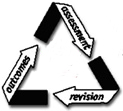Assessment Brief #80 - The Daily Class Summary: A Teaching and Learning Tool

February 2014
Author: John M. Jeep, GREAL
Professor of German & Director, Linguistics
First-Generation Student Mentor
The Daily Class Summary is a pedagogical tool that supports student learning outcomes relating to course content, writing skills, and higher-level cognition. It individually and collectively enhances student engagement and responsibility, while providing the students and the instructor with a learner's perspective on each class meeting. The summary addresses specific Global Miami Plan learning outcomes.
For each class I teach, I assign one student (at least) to write a class summary of circa 350 words. The summary is, as a rule, to be in prose, not bullet points, and is designed, among other goals, to provide a student who was absent an opportunity to learn what was accomplished during the class (including details of announcements of co-curricular activities). Any audio and/or visual materials that supplemented the class meeting are included per attachment. Timely submission provides time for the instructor to read, edit where necessary, and post the summary on Niihka (or other site) prior to the next class meeting. There the summary becomes part of the course record.
Benefits
- It is a relatively low-risk opportunity for the writer to demonstrate formal writing skills (e.g. organization, error-free composition), while reinforcing their own learning and that of others.
- It provides the summarizer with an opportunity for feedback from the instructor and/or from other students on their writing and on their grasp of course material.
- It provides the instructor with a student perspective on the class. It is especially helpful following discussions in which the course of the discussion is not necessarily predetermined. Errors and other concerns can be discerned and addressed.
- It provides students who were absent with a record of what went on and an opportunity to respond to the material covered and the summary itself. I generally request students to respond by email to the instructor, ideally before returning to class.
- The material becomes part of the course record. It can thus easily be referenced (e.g. by author and date) in formal writing assignments. In this way it allows students to practice responsible citation.
- It allows students to revisit the course meeting from another learner's perspective. This can serve as a corrective (or substitute) to their own note taking, and a study aid. I designate the class summary as part of the course reading materials. An instructor could assign students to respond to one or more summaries.
- It is potentially very helpful for non-native speakers of English, especially following a lively in-class discussion. This potential use also applies to other students with learning challenges.
Additional Curricular Implication
The class summary can be used to explicitly underscore the Global Miami Plan Principles (critical thinking, understanding contexts, learning from your peers, reflection and action), which, as higher-level cognitive activities, may be less immediately apparent in a class discussion focusing on specific course material. The summarizer could be asked to identify at least one of these principles as evident in the class meeting. The composition of a class summary is itself an instance of reflection and action, and that student use of the summary addresses the foundational goal of engaging with other learners. The assignment itself calls for critical thinking and understanding context.
Nuts and Bolts
- The Class Summary is described in the syllabus. Students sign up for dates to record. In a large class, some days will have more than one student assigned, allowing comparison of accounts.
- Summaries are due, for example, at noon the day following class; I edit and post them more or less immediately. In foreign language classes, I ask the students to describe and self-assess their linguistic errors. This could of course be used in English language summaries, as well, by examination of instructor edits to student entries.
- Summaries allow the possibility to participate in class discussions ex-post-facto via email, blogs, discussion groups, etc. which may be valuable if students were not sure they were following well.
- A variation would be, instead of allowing students to sign up for a date, to only reveal the class summarizer at the end of class. This would compel all present to take notes (more?) carefully. I have not yet attempted this.
Feedback
Students are generally satisfied with individual summaries. Course evaluations have repeatedly mentioned satisfaction with the class summaries, e.g.,
- "It taught me that I really could be fully engaged for almost two hours straight at 8 am!"
- On 'Engaging with Other Learners': "This one is pretty easy to relate, because we have 33 summaries on Niihka detailing the various discussions we had in the course of the semester."

